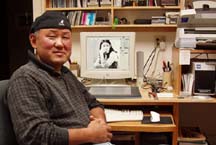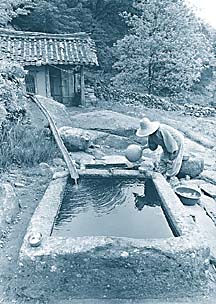|


Feb. 26, 2004
COVER
STORY | IN THE NEWS | PUBLISHER/EDITORIAL
THE HUM | PREVIEW | CALENDAR
Suk
Choo Kim
by LINDA MITCHELL
W HEN I VISITED MY OLD FRIEND
SUK CHOO KIM [ photo below,
left, by Linda Mitchell] in Bayside
the other day to talk about his upcoming photography exhibit,
it occurred to me that he isn't  exactly
a starving artist. He lives in a big house in an exclusive gated
community, just down the road from Baywood Golf and Country Club,
where he and his wife, Young Mi, are members. He has a fine art
collection, his kids go to good schools, and he's able to travel
whenever he wants. exactly
a starving artist. He lives in a big house in an exclusive gated
community, just down the road from Baywood Golf and Country Club,
where he and his wife, Young Mi, are members. He has a fine art
collection, his kids go to good schools, and he's able to travel
whenever he wants.
"I have a very, very successful
business," he said, referring to CPR Aquatic, the Arcata-based
aquarium hardware company he founded 12 years ago. "I have
plenty of money and a beautiful home that's all paid for. I'm
a good businessman, but if that's all you are, it doesn't mean
anything. You need a balance. My art gives me that."
Suk Choo, 55, says most people
know him only as a businessman and don't realize he's also an
artist. Since he hasn't shown his work professionally in more
than 20 years, I guess that's not surprising, but it seems like
a shame. For a long time, Suk Choo's identity as a photographer
was firmly established in the international art world, and with
good reason. His work is remarkable, and it has steadily evolved
over the 40 years he's been obsessed with the medium.
He took me to an upstairs hallway
and gave me a preview of the new "piezograph" prints
he'll be exhibiting in March, in the gallery adjoining Consider
the Alternatives Bookstore in Eureka. "They're carbon-based
dye prints," he explains. "They're permanent when you
use the right kind of paper, meaning they can go 200 years without
fading. You get a nice tonal range with the medium."
The prints are from perfectly
composed, richly textured images Suk Choo took of Buddhist monks
and monasteries in Korea and Carmel 20 to 30 years ago. His parents
were devout Buddhists and frequently toured the great Korean
temples, so this is familiar territory. He knew the people and
places he photographed intimately.
[Photo at right:
Monk At Spring Water
by Suk Choo Kim]
"My father practiced Buddhism
in the true sense, like it's supposed to be practiced. Even though
he was a layman, he was more strict than most monks." Suk
Choo laughs, remembering. "He could get really angry at
the monks -- he looked at how strictly people practiced, that's
what counted."
His father was a successful
businessman in Korea. When he retired, he founded the Sambosa
Buddhist Temple in Carmel, where the entire family was actively
involved.
Being in Carmel lead to Suk
Choo's involvement with Friends of Photography, the nonprofit,
member-supported organization founded by Ansel Adams and other
well-known photographers in Carmel in 1967. "Being there
opened my eyes," he remembers. "They had a beautiful
gallery and workshops with all these incredible artists."
The names of the artists Suk Choo was rubbing elbows with at
that time reads like a who's who of photography. "I was
a groupie. I worked there just so I could meet the photographers.
I knew Ansel Adams in person, all the Weston's, Jerry Uelsmann,
Ralph Gibson when he was just a young guy. Minor White used to
send me letters when I was in the Army."
By the early 1980s Suk Choo
was well on his way to a promising career as a photographer.
He did free-lance work for magazines, worked as a staff photographer
during his stint in the U.S. Army, founded Young Sang
(the first and largest photographic magazine in Korea), published
a book, Screamers, and exhibited his work in more than
70 shows around the world, including a major exhibition at the
Oakland Museum in 1982. And then suddenly it was over.
Suk Choo says he quit showing
professionally after the Oakland show because of bad reviews.
"When I was younger, I was foolish enough to want to be
recognized as a photographer. Everybody surrounding me was telling
me I was a great artist, but I was basically doing copies of
other people's work -- there's nothing wrong with that, but it's
immature. I didn't deserve a major show. I wasn't ready."
He says he decided to turn his
attention to making money. "Something else I'm good at,"
he jokes. I ask how many businesses he's owned. "Lots,"
he says, ticking off a few of them. "There was Amica [gallery,
art supply, photo supply, graphic printing, publishing, fashion
accessories], Sundance Leather Company, Lintec Corporation in
Carmel where we made 3-D cameras, Barnyard Photo Lab, Kim's Restaurant
-- lots of things."
With all these accomplishments,
it's easy to forget he's also an artist -- until you see his
archives, that is. He showed me dozens of black photo boxes,
packed to the brim with prints, stacked up in his studio and
a storage room, labeled in silver ink: Family, Army, Monks, Mexico,
Korea, Arcata, Dreams, Screamers...
His archives reflect the evolution
of his imagery, as well as his printing techniques, which are
now almost exclusively digital. "Here's what's happening,"
he says. "I have a beautiful darkroom, but when you're doing
the printing you have to set up the chemicals and you don't want
to waste them so you stay there three or four hours, developing,
washing, drying -- I don't have that kind of time. I want to
be able to do it when it's convenient."
He says he's been playing around
with digital printing for several years and that his style is
changing with the technology. "I shoot different types of
images now, because the medium I'm working with is completely
different than silver gelatin."
Is he ready to begin exhibiting
again? "Absolutely," he says, adding, "I have
enough work for about 50 shows. The Monks show is just
a teaser." He says it's no longer about being recognized
as a photographer, though.
"I just make pictures now.
I don't worry about making history. I made a commitment to myself
that, as long as I'm home, I'll make a print every day, minimum.
If I haven't made a print, I don't go to bed. This medium lets
me do that. I don't care whether they're good or bad. If my work
means anything after I'm gone, that's great. If not, who cares?
I'll be dead."
Monks runs March 6-30 at
Consider the Alternatives Gallery, 300 Second St., Old Town,
Eureka. An Arts Alive! opening is scheduled for March 6.
Linda Mitchell can be reached
via
COVER
STORY | IN THE NEWS | PUBLISHER/EDITORIAL
THE HUM | PREVIEW | CALENDAR
Comments?

© Copyright 2003, North Coast Journal,
Inc.
|